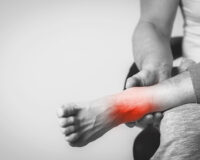
Ankle Sprains
Ankle sprains are one of the most common musculoskeletal presentations around. Affecting most of the population (sport or no sport) at one time or another. Reports show that anywhere up to 75% of people suffering from an initial lateral ankle sprain (a sprain to the ligaments on the outside of the foot) will go on to sprain their ankle repetitively (Hubbard TJ, Wikstrom EA 2010). As many as 55% of people do not rehabilitate their ankle sprains or seek medical advice post-ankle sprain (Guillo S et al. 2013).
What is an ankle sprain?
An ankle sprain is the stretching (and sometimes rupturing) of the supporting tissue (ligaments) which attach bone to bone and stabilise either the inside or the outside of our ankle. The most common ankle sprain being the stretching or tearing of the ligaments on the outside (lateral) ankle. This normally occurs when you roll your ankle in a downwards and inwards direction.
What is chronic ankle instability?
If an ankle is not rehabilitated properly, this increases the individual’s risk for recurrent ankle sprains; also known as chronic ankle instability (CAI). Approximately 30-40% of people will develop CAI following a lateral ankle sprain (Vuurberg G et al. 2018). CAI is diagnosed by a few criteria – recurrent sprains (>1), soreness, swelling, giving way and activity avoidance for 12 months or more (Guillo S et al. 2013; Vuurberg G et al. 2018)
There are three classifications of a lateral ankle sprain:
Grade 1: Mild stretching or tearing of the ligament
Grade 2: Moderate stretching/tearing of the ligament
Grade 3: Complete rupture of the ligament
What sports are more vulnerable?
Any sports requiring jumping, turning, twisting and/or change of direction are vulnerable to lateral ankle sprains. These include:
- Dance
- Football
- Tennis
- Basketball
- Netball
- Soccer
- Rugby
What predisposes an individual to an ankle sprain?
- Having a previous ankle sprain
- Not rehabilitating previous sprains properly (including strength, balance work and sport specific rehab/jump training if appropriate)
- Decreased muscle strength
- Increased or decreased ankle joint flexibility
- Poor balance
- Poor footwear
- Inadequate or no support to ankle joints which have been injured (ie. require tape or brace)
Signs & symptoms
The signs and symptoms of an ankle sprain will differ depending on the grade of the sprain.
Grade 1 normally consists of:
- Mild soreness
- Potentially mild bruising/swelling
- Little to no joint laxity
- Decreased balance
- May or may not disrupt play
Grade 2 consists of:
- Swelling and bruising around the ankle
- Significant soreness and joint instability
- Reduced balance
Grade 3:
- Severe swelling and bruising around the ankle
- Can experience little to no soreness after initial injury as the ligament fibres have been torn completely
- Significant joint instability
- Decreased balance
Treatment options / rehabilitation
In the first few days following an ankle sprain, it is important to follow the RICE principle:
- Rest the joint
- Ice the area – wrapped in a damp tea towel 10-15 minutes every 2 hours (if you have full sensation and do not react to the cold)
- Compression to the joint (e.g. Tubigrip, but this should NOT be too tight, or worn overnight)
- Elevation of the joint in order to reduce swelling
It is also important to avoid heat, alcohol and massage in the first 48-72 hours
Following this short protective period, rehab can commence which may include:
- Ankle range exercises
- Joint mobilisation around the ankle – including after multiple sprains as you can have some unhelpful stiffness of bones around the ankle
- Soft tissue massage
- Taping/bracing
- Strength exercises for your ankles, calves, hips and core
- Balance exercises to prevent recurrence
- Jump and hop training
- Sport specific drills
Occasionally, treatment may involve surgery.
Return to play / dance
After rehabilitation and clearance to play, it is important for the ankle to be supported during games for anywhere from 6-12 months. This involved strapping or bracing the ankle for training and games.
Important information regarding ankle sprains:
It is important to seek a health professional to assess your ankle after injury in order to rule out more severe injuries including bone fractures and high ankle sprains aka syndesmosis injuries (blog post to come)
None of the information in this article is a replacement for proper medical advice. Always see a medical professional for advice on your injury.
To know more about ankle soreness and to get an assessment, book to see one of our Practitioners (Physiotherapist, Massage Therapist) below.
Book Appointment



